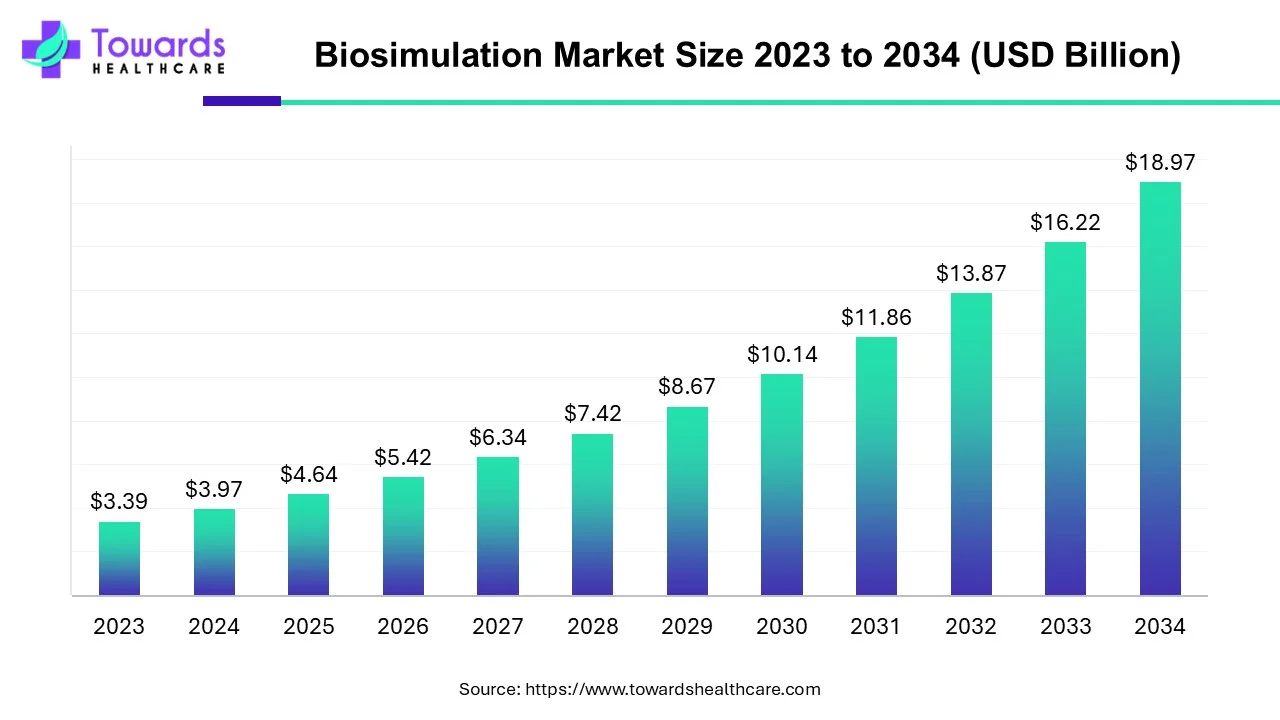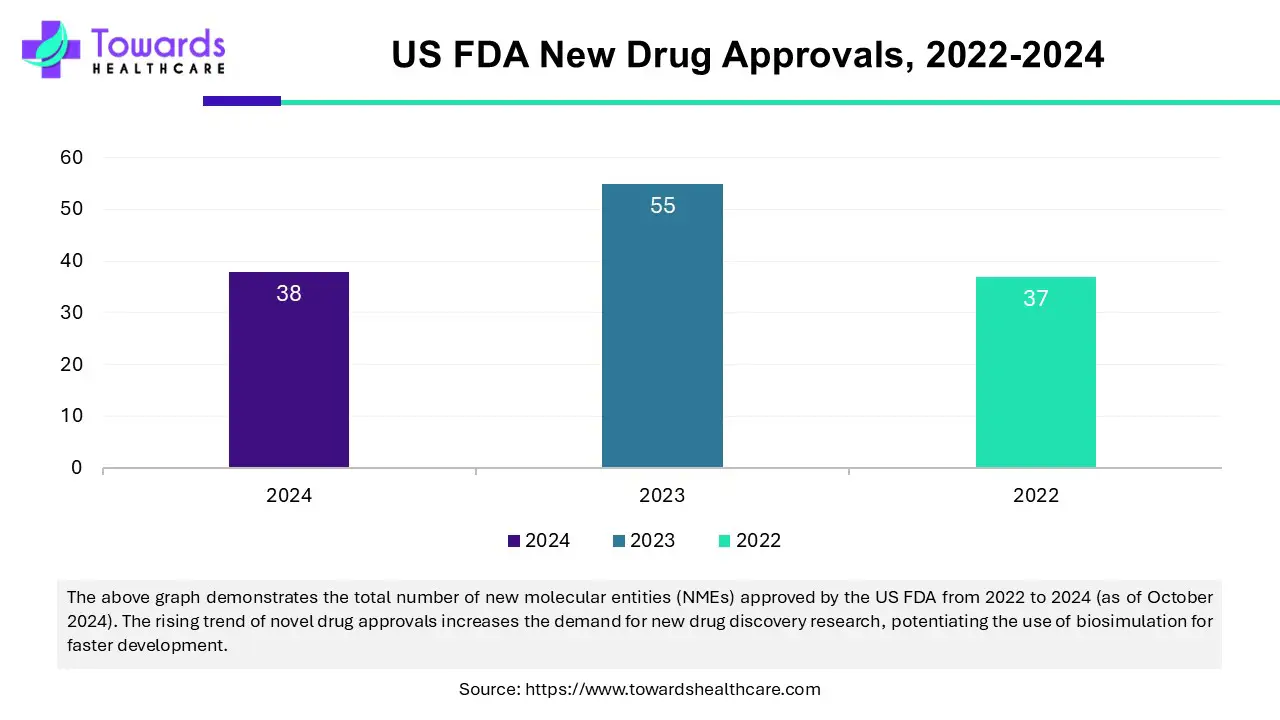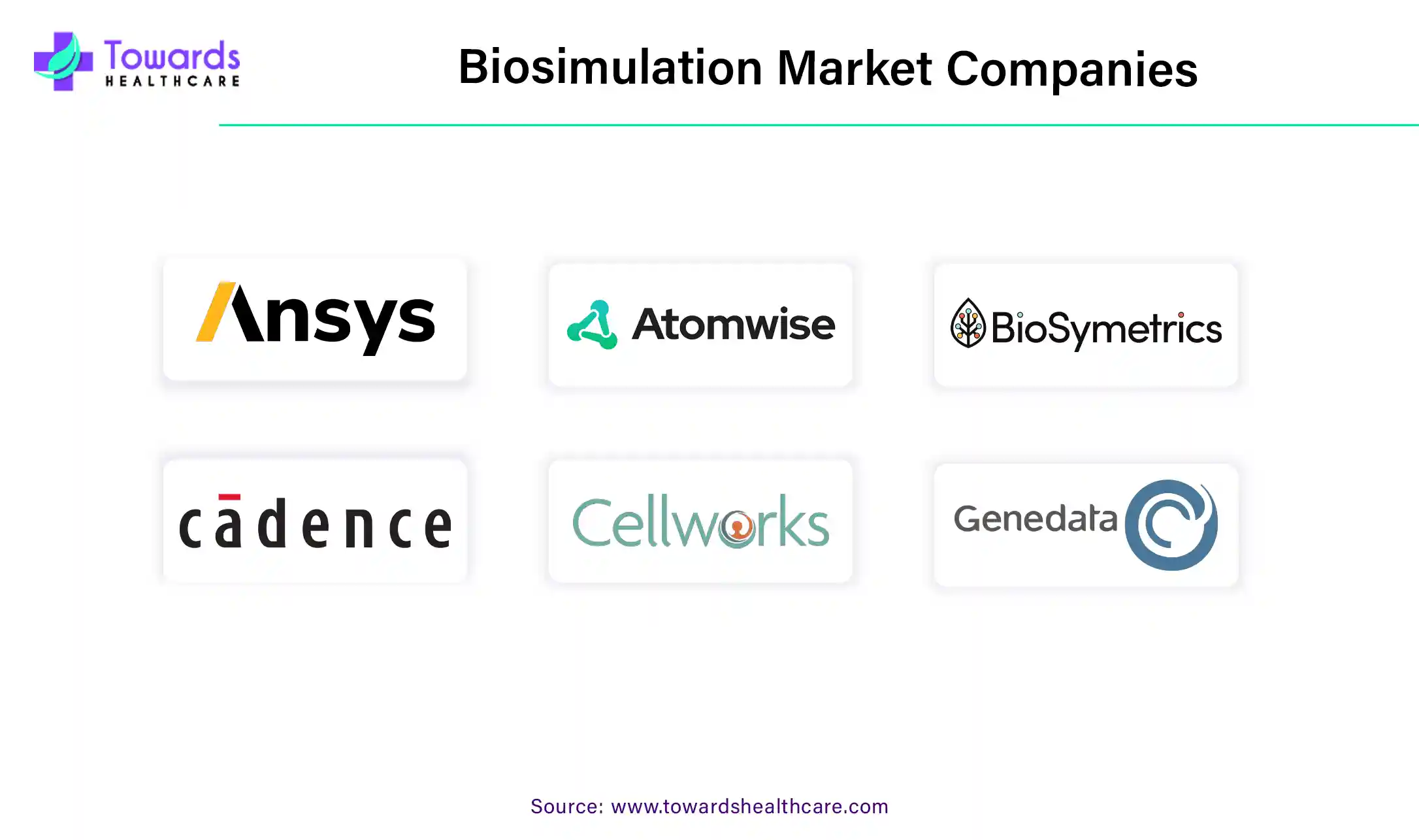April 2025

The global biosimulation market size is calculated at USD 3.97 billion in 2024, grew to USD 4.64 billion in 2025, and is projected to reach around USD 18.97 billion by 2034. The market is expanding at a CAGR of 16.94% between 2024 and 2034. Technological advancements, increasing investments in R&D, and growing demand for personalized medicines drive the market.

Biosimulation is a process of simulating the dynamics of the biological system using mathematical expressions on modern computers. This process helps researchers gather important data about how biological systems behave without conducting such tests in living organisms, including animals and humans. Researchers adopt the biosimulation process to understand the complexity of human physiology and predict the response to therapies. Several market players develop software and solutions to measure numerous properties such as pharmacokinetics and pharmacodynamics, bioequivalence, and toxicity profiles of a drug. Hence, this process accelerates drug discovery and development, facilitates collaboration, data integration and regulatory compliance, and improves patient outcomes.
The rising incidences of several acute and chronic disorders necessitate the development of drugs and drug delivery systems that require biosimulation software. The increasing investments in R&D by several pharmaceutical and biotechnology companies for drug discovery and the increasing number of new drug approvals increase the demand for biosimulation. The advancements in technology and the complex drug discovery process boost the biosimulation market.

Nowadays, artificial intelligence (AI) is an integral part of the healthcare ecosystem, including pharmaceutical and biotechnology R&D processes. AI catalyzes the biosimulation process and streamlines the drug discovery and development process. Biosimulation models use AI and machine learning (ML) to find patterns and evaluate relationships between drugs, patient populations, and clinical trial parameters. Hence, these models allow researchers to explore optimal dosing, medication interactions, and population-level efficacy. Leveraging AI can comprehend complex data types, reducing the time of scientists for tedious computational analyses and research tasks. The data collection and analysis become easier with the help of AI. Additionally, the advent of cloud platforms for biosimulation enables making predictions, analyzing results, sharing conclusions, and making decisions through a single web browser interface.
Complex Drug Discovery Process: The discovery of novel drugs is a very complex, lengthy, and costly process. The entire drug discovery process consists of five main steps: the pre-discovery stage; the drug discovery stage; preclinical development; clinical development; and reviewing, approval, and post-market monitoring stage. The entire process takes around 12-15 years with an approximate cost of billions of dollars. Initially, around 5,000 to 10,000 chemical compounds are tested, of these, only 1 or 2 drugs qualify for marketing. Hence, more than 90% of the drugs fail during the drug discovery process. However, biosimulation plays a vital role in accelerating the drug discovery process by significantly reducing the time and cost of discovering high-quality drugs. The major reasons why a drug fails in the preclinical or clinical stage are predicted using software on a prior basis, facilitating researchers to eliminate the potentially harmful candidates at an initial level.
Lack of Skilled Professionals and High Upfront Cost: The major challenge of the biosimulation market includes the lack of skilled professionals. There are only a few qualified experts having expertise in the biosimulation field. Hence, the lack of trained professionals restricts the use of biosimulation software by many academic institutes and pharmaceutical companies, especially in the LMICs. Another major challenge is the high installation and technique development cost of the software. Not all companies, CROs, or academic research institutes can afford biosimulation software, limiting its use.
Latest Innovations: The rising adoption of biosimulation software by pharmaceutical companies, academicians, and CROs lead to the development of novel innovations in the biosimulation market. Several researchers and organizations use biosimulation software for developing personalized medicines. The growing demand for personalized medicines and favorable government policies supporting precision medicine research through funding augment the market. Biosimulation provides a deeper understanding of the effect of drugs within an individual’s body, thereby stimulating novel precision medicine development.
Apart from precision medicine, biosimulation is also widely accepted for developing cell and gene therapy (CGT) products. Biosimulation overcomes the challenges involved in CGT development such as the risks of developability and balance of safety and efficacy. Hence, biosimulation can determine if personalized therapy and CGT will be cost-effective or better than the standard of care.
By product, the software segment dominated the biosimulation market in 2023. Biosimulation software enables researchers to model and simulate complex biological systems, predict drug behavior, optimize treatment strategies, and reduce cost and time. The software offers a complete solution to the researchers and can be used numerous times during the subscription period. The biosimulation software can be used anywhere and at any time by the researchers, favoring real-time data analysis.
By product, the services segment is projected to expand rapidly in the market in the coming years. Several companies offer biosimulation services to measure several parameters required during drug development. Services save a lot of time for researchers and are cost-effective. Organizations and academic institutes that lack expertise in biosimulation, prefer biosimulation services. Biosimulation services can be either in-house or contract-based.
By application, the drug development segment held a dominant presence in the biosimulation market in 2023. Drug development involves screening a large set of molecules and determining the safety and efficacy of drugs. Only a few novel drugs get regulatory approval and enter the market. Biosimulation streamlines the entire process by predicting various parameters of the drugs. The increasing number of novel drug discovery research and rising R&D investments boost the segment’s growth.
By application, the drug discovery segment is expected to grow fastest in the market during the forecast period. The rising incidences of acute and chronic disorders, increasing novel drug discovery research, and demand for personalized therapy potentiate the segment’s growth. Biosimulation helps to find the correct and potential drug candidate against a specific disease, thereby reducing the time and cost of research. The rising number of new drug approvals favors the use of biosimulation for drug development. The Chinese regulatory agency, NMPA, approved 104 new drugs in 2023 compared with 77 new drugs in 2022.
By end-use, the pharmaceutical & biotechnology companies led the global biosimulation market in 2023. The segment’s growth is attributed to the increasing number of novel drug discovery and development research, availability of capital investments, and increasing collaborations. The fast and effective new product launches strengthen the company’s position in the market, increasing the demand for the use of computer modeling. The adoption of biosimulation by these companies improves productivity and optimizes resources.
By end-use, the CRO segment is anticipated to grow with the highest CAGR in the market during the studied years. Contract research organizations (CROs) provide numerous pharmaceutical and biotechnology research services outsourced on a contract basis. The increasing number of CROs due to the demand for efficient services boosts the segment’s growth. CROs widely use biosimulation to design and execute the research process and clinical trials. The presence of technical expertise and suitable infrastructure favor market growth.
North America held the largest share of the biosimulation market in 2023. The increasing number of new drug approvals, the presence of key players, and technological advancements drive the market. The US Food and Drug Administration (FDA) actively supports the use of digital health technologies in clinical drug development. It has also developed a program “Framework for the Use of DHTs in Drug and Biological Product Development” to increase awareness through workshops, publication of guidance documents, and establishment of internal processes.
Similarly, the Government of Canada also supports the adoption of cutting-edge technologies and approaches to accelerate drug discovery and develop new drugs and effective treatments for Canadians. The Government also announced funding of $49 million in 2023 for the creation of the Conscience Open Science Drug Discovery Network. Furthermore, the increasing number of pharmaceutical companies and CROs increase the demand for biosimulation. There are more than 5,000 pharmaceutical companies and 4,323 CROs in the U.S. Whereas, in Canada, there are currently more than 3,000 pharmaceutical companies.
Asia-Pacific is anticipated to grow at the fastest rate in the biosimulation market during the forecast period. The increasing number of pharmaceutical and biotechnology companies, growing research and development, and increasing investments & collaborations drive the market. In H1 2022, the Chinese pharmaceutical companies concluded 101 deals, accounting for a total of $10.2 billion in investment. Japan's government also supports new drug discovery research through the “Strengthening Drug Discovery Venture Ecosystem Project” with a 300 billion yen budget in 2022. Additionally, the Indian pharmaceutical market is booming with increasing investments, manufacturing, and innovation. The increasing number of clinical trials also potentiate the market. The Chinese pharmaceutical companies initiated 96 pivotal clinical trials. While Japan accounted for a 4.7% share of the global clinical trials activity in 2022.

Max Kanevsky, Chief Technology Officer, Certara, commented on the launch of its Phoenix 8.5 software launch that the company develops software solutions that transform research data into trustworthy insights for scientists and regulators to bring new medicines to market faster. The latest version of their software includes new capabilities requested by existing clients and their IT business partners.
By Product
By Application
By Delivery Model
By End-Use
By Region
April 2025
April 2025
April 2025
January 2025